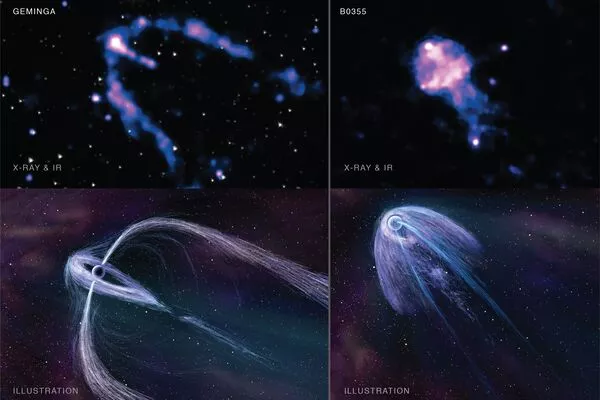Telescopes are critical in solving the pulsar mystery. Pulsars are neutron stars that rotate quickly and release beams of electromagnetic radiation, including radio waves. These beams can be viewed with radio telescopes, as well as other types of telescopes, and investigating pulsars has long been a focus of astronomical research.
Astronomers have discovered the odd behavior of a pulsar, a super-fast-spinning dead star, using a unique observational campaign including 12 telescopes both on the ground and in space, including three European Southern Observatory (ESO) facilities. This intriguing object is known to transition between two brightness modes virtually constantly, which has remained a mystery until now. But astronomers have now found that sudden ejections of matter from the pulsar over very short periods are responsible for the peculiar switches.
“We have witnessed extraordinary cosmic events where enormous amounts of matter, similar to cosmic cannonballs, are launched into space within a very brief time span of tens of seconds from a small, dense celestial object rotating at incredibly high speeds,” says Maria Cristina Baglio, researcher at New York University Abu Dhabi, affiliated with the Italian National Institute for Astrophysics (INAF), and the lead author of the paper published today in Astronomy & Astrophysics.
We have discovered that the mode switching stems from an intricate interplay between the pulsar wind, a flow of high-energy particles blowing away from the pulsar, and matter flows towards the pulsar.
Coti Zelati
A pulsar is a rapidly rotating, magnetically dead star that produces an electromagnetic radiation beam into space. This beam sweeps over the galaxy as it rotates, similar to a lighthouse beam scanning its surrounds, and is detected by astronomers as it intersects the line of sight to Earth. As seen from our planet, this causes the star’s brilliance to pulse.
PSR J1023+0038, or simply J1023 for short, is a peculiar type of pulsar. It orbits another star near to 4500 light-years away in the Sextans constellation. Over the last decade, the pulsar has been aggressively dragging matter away from its companion, which has accumulated in a disc around the pulsar and is progressively falling towards it.
Since this process of accumulating matter began, the sweeping beam virtually vanished and the pulsar started incessantly switching between two modes. In the ‘high’ mode, the pulsar gives off bright X-rays, ultraviolet and visible light, while in the ‘low’ mode it’s dimmer at these frequencies and emits more radio waves. The pulsar can stay in each mode for several seconds or minutes, and then switch to the other mode in just a few seconds. This switching has thus far puzzled astronomers.

“Our unprecedented observing campaign to understand this pulsar’s behavior involved a dozen cutting-edge ground-based and space-borne telescopes,” says Francesco Coti Zelati, a researcher at the Institute of Space Sciences, Barcelona, Spain, and co-lead author of the paper. The campaign included ESO’s Very Large Telescope (VLT) and ESO’s New Technology Telescope (NTT), which detected visible and near-infrared light, as well as the Atacama Large Millimeter/submillimeter Array (ALMA), in which ESO is a partner. Over two nights in June 2021, they observed the system make over 280 switches between its high and low modes.
“We have discovered that the mode switching stems from an intricate interplay between the pulsar wind, a flow of high-energy particles blowing away from the pulsar, and matter flowing towards the pulsar,” says Coti Zelati, who is also affiliated with INAF.
Matter moving towards the pulsar is discharged in a narrow jet perpendicular to the disc in the low mode. This matter gradually accumulates closer to the pulsar, and when it does so, it is hit by the wind coming from the pulsating star, causing the matter to heat up. The apparatus is now in high gear, emitting dazzling X-ray, ultraviolet, and visible light. Blobs of this heated stuff are eventually expelled by the pulsar via the jet. Because there is less heated stuff in the disc, the system flashes less brightly and returns to the low mode.
While this discovery has solved the mystery of J1023’s odd behavior, astronomers still have a lot to learn from studying this unique system, and ESO’s telescopes will continue to aid astronomers in their observations of this strange pulsar. ESO’s Extremely Large Telescope (ELT), which is currently being built in Chile, will provide an unprecedented glimpse of J1023’s switching mechanisms.
“The ELT will allow us to gain key insights into how the abundance, distribution, dynamics, and energetics of the inflowing matter around the pulsar are affected by the mode switching behavior,” says Sergio Campana, Research Director at the INAF Brera Observatory and co-author of the article.
















